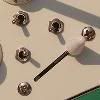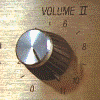|
|
Post by borsanova on Nov 3, 2006 19:06:05 GMT -5
Here is my improved version of Jimmy Page's Les Paul. I call it the Les Paul Twenty-Dual. It has 22 different sounds, one more than Jimmy's, since it includes also a dual sound for the bridge pickup (in my case a Duncan JB) with parallel wiring for both coils instead of serial. Moreover I eliminated the muted positions on Gibson's reissue and I moved the push/pull controls to a more rational configuration (Jimmy's original has the coil tap switches on the volume controls). On my guitar they are moved to the tone pots while the switches on the volume pots control serial and out-of-phase switching: Here is what the four push-pull pots do: The bridge volume control switches both pickups in serial mode, but only when the bridge pickup is selected. With the pickup selector in the middle or on the neck you only hear the neck pu. The neck volume control switches the neck pu out of phase. It only works with both pickups selected, that is with the pickup selector in the middle position or, when serial mode is selected, with the pickup selector in the bridge position. The bridge tone control switches the bridge pickup from serial humbucker to parallel (Dual sound). The neck tone control switches the neck pickup to single coil and, when the bridge tone control is pulled, it also switches the bridge pickup to single coil. Why I recombined the push/pull pots? I think my configuration is much more rational, because it puts each switch exactly where you would search and eventually miss it on a standard guitar. Here are my arguments for each new combination. Tone controls and coil tap: Usually guitarists use their tone controls to muffle their sound and that's what they do best. But almost as often you touch the same controls hoping to find some space for brightening your sound. How many times have you been frustrated, finding that the tone control was already at ten? On my Les Paul you have the solution immediately at hands: just pull your switch for dual sound or coil tap and the sound will become brighter. Bridge volume and serial: Serial wiring of two pickups brings the highest volume and distortion. Usually you need it when you're playing solo, that is you're already playing your bridge pickup and often you need more volume to come up against the other instruments. When you reach down to the volume knob and find you're already at ten, a little pull can now provide the ultimate boost you were looking for. Neck volume and out-of-phase: The out-of-phase switch should in any case be combined with a volume control, because only the latter permit to control the equilibrium between the two signals. By differentiating the volume of each pickup you can mix the signals and control how much of the lower frequencies will be cancelled. Often you will find that you pull your out-of-phase switch and that your sounds becomes much thinner than you expected. In this case you got your fingers already where it counts. Simply reduce your neck volume from ten to eight and you'll hear how your sound becomes thicker again. Reassuming in the simplest manner, my guitar has one push/pull switch that makes the sound fatter (the bridge volume) and three push/pull switches that make it thinner. This makes it really easy to handle and if you remember these main rules it is almost impossible to get lost between the switching possibilities (which is not so improbable on many modded Stratocasters or on a Brian May Red Special). How I got to my Twenty-Dual wiring? I had already designed my 21 mode wiring scheme, when I decided to try and change the bridge pickup mod from single coil to parallel (Dual sound). It is not too difficult and when I finished it, I started to study hum-cancelling effects of the combined modes. So I realized that it wasn't very smart to combine a parallel humbucker with a single coil, since this would never be hum-cancelling. Then my eyes fell on the neck tone pot which had still an unused pole and I thought I could use this to switch the bridge pickup to single coil when combined with the neck single coil. That's it. Now I got 16 two-pickup combinations (like Jimmy's), and six one-pickup modes (one more than Jimmy): neck humbucker neck adjustable coil neck stud coil bridge adjustable coil bridge parallel coils (dual sound) bridge humbucker The pickup wirings in combination are always: parallel in phase parallel out of phase serial in phase serial out of phase all four with four pickup combinations: both humbuckers neck single coil and bridge humbucker neck humbucker and bridge dual (or parallel) coils both single coils If you do it right, three of these combinations will always be hum-cancelling and only the second one is not. That makes up for a total of 15 hum-cancelling sounds and only 7 that aren't, a much better ratio than on Jimmy's guitar which has only at best 10 hum-cancelling sounds. Enough words for now! Here is my schematic: 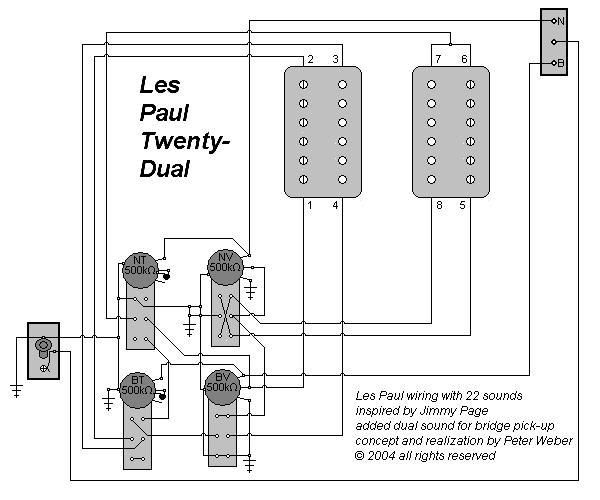 |
|
|
|
Post by borsanova on Dec 16, 2006 18:38:21 GMT -5
The following is a wiring instruction for my Les Paul Twenty-Dual:
Maybe it is useful, too. Included in this description is a mini toggle switch, which gives 8 more combinations, all non hum-canceling. I installed it hidden in my back routing, just to find out how they'd sound, but I only used it in the very first weeks. This switch is not represented in my schematic.
Let's start with the definitions.
As I told before there are four push-pull pots, named as follows and with different functions:
NV : The neck volume control switches the neck pu out of phase
BV : The bridge volume control switches both pickups in serial mode, but only when the bridge pickup is selected. With the pickup selector in the middle or in the neck position you only hear the neck pu.
BT : The bridge tone control switches the bridge pickup from serial humbucker to parallel humbucker.
NT : The neck tone control switches the neck pickup to single coil and, when the bridge tone control is pulled, it also switches the bridge pickup to single coil.
Each switch has six lugs placed and named as follows:
1+ +2
3+ +4
5+ +6
1 and 2 are the upper lugs for pulled mode, 5 and 6 are the lower lugs for pushed mode.
Thus, for instance, BV3 means the left middle lug of the bridge volume switch.
Each pot (NVP, BVP, BTP, NTP) has three lugs, named a, b and c, where a is placed at one o'clock, b is at two o'clock and c is the grounded lug at three o'clock.
The bridge pickup (BPU) has four wires: 1,2,3,4.
The neck pickup (NPU) has at least three wires: 5,6+7(coil tap),8.
These are the connections:
NV1 to NV6
NV2 to NV5 and NPU8
NV3 to ground
NV4 to NVb and BV2
NV5 to NV2
NV6 to NV1 and NPU5
NVa to pickup selector and NTP
NVb to NV4
BV1 to BV2
BV2 to BV1 and NV4
BV3 to BT1
BV4 to BPU4
BV5 to ground
BV6 to ground
BVa to pickup selector and BTP
BVb to BPU1 and NT4
BT1 to BV3
BT2 to NT6 (eventually passing over mini-switch)
BT3 to BPU2
BT4 to BPU3
BT5 to BT6
BT6 to BT5
NT1 to ground
NT2 - (eventually to mini switch)
NT3 to NPU6+7
NT4 to BVb
NT5 -
NT6 to BT2 (eventually passing over mini-switch)
That's all. Considering also the mini-switch this will give you 30 different combinations.
Good luck!
|
|
|
|
Post by borsanova on Dec 16, 2006 18:54:31 GMT -5
My guitar is an Epiphone Les Paul with a Seymour Duncan JB (16k) in the bridge position and a DiMarzio PAF (8,5k) in the neck position. In a first moment, when I finished my wiring, I realized that the single coil combinations were not hum-canceling. I don't know if this was due to the fact that I used Duncan and DiMarzio in combination or maybe because the DiMarzio came possibly from a bridge position (though I bought it as neck pu on Ebay, it came with very short wires).
In order to solve the problem, some advisors suggested to flip the magnets in one of the pickups, but I found an easier way. In fact I flipped the in/out connections with the coil tap connections on my DiMarzio. So on my guitar connections 5 and 6 are reversed as well as 7 and 8. You should take this into account and try it out before definitely installing your pickups.
|
|
|
|
Post by borsanova on Dec 16, 2006 19:11:36 GMT -5
Here are some impressions I posted on another board shortly after finishing my Twenty-Dual (At that time I still had my Epiphone stock pu, which gave me some problems regarding the equilibrium when switching from bridge to neck) :
I've played my Jimmy Page Les Paul for a week and I'm still exploring all the possibilities. But I think I can add some more about the different tonal characters of some of the pickup combinations.
First I want to say that after a few days I've returned my mini-switch back to the original idea. The 3-single-coils mode is quite funny for a while, delivering some curious funky sounds, but I can do without that especially since the 2-single-coils combinations come quite close to it.
So the four possibilities are now like pointed out at the beginning of this post:
1. both humbuckers
2. neck single coil and bridge humbucker (serial)
3. neck humbucker (serial) and bridge humbucker (parallel)
4. both single coils
There is one big advantage to this that regards in particular the third combination and I'll try to explain it here (sorry, but will take a bit longer):
For many years I've played only on my Ibanez ES 345 which has two PAF pickups that are completely identical. On this guitar I developed my habit to switch between the two pickups inside a song. Two examples may be Neil Young's Powderfinger and Thin Lizzy's Southbound. Towards the end of the refrain I switch to the bridge pickup to accentuate the harder guitar phrases. At the beginning of the next verse I go back to the neck (with a little
tone control, too). But I hate it, if these changes sound to evident, especially when I get back to the neck. To avoid this you need two pickups in a good equilibrium. That was even the case with the two stock humbuckers in my Les Paul, but since the day I changed the bridge pu, I've always been fighting to control the output gap between the two pickups. Putting in a 17k JB has even worsened the situation and when I first played one of the songs above I almost regreted replacing the originals. But then I discovered that there is a quite simple solution. I just put the JB in parallel mode and it goes back to 8,5k like a slightly hotter PAF humbucker. The result is a perfect equilibrium between the two pickups and moreover even a nice equidistant inbetween sound with both pickups in parallel :-))
The JB in parallel comes really close to a nice PAF sound and thus I got now at least two guitars in one. With ultra hot bridge pu in combination 1 and with a PAF sound in combination 3. The songs above are now played with combination 3 and when it comes to the solos I still got reserves like turning the bridge to serial or throwing in the neck in serial mode.
I guess this could be a quite interesting lesson for all of you guys who got the Seymour Duncan favorite combination with a JB in the bridge and a Jazz in the neck. One push pull switch for parallel mode of the JB and you'll have a classic PAF guitar, too!
|
|
|
|
Post by borsanova on Dec 16, 2006 19:24:44 GMT -5
A good question and my answer:
From: Steve A.
Date: 2/25/2005 4:11 PM
Subject: Re: Jimmy Page Les Paul wiring
I didn't realize that you were switching the internal wiring of the bridge humbucker from series to parallel; I think it was DiMarzio who introduced that to most of us, calling it "Dual Sound". It was offered mainly as an alternative to splitting coils, as it would retain the humcancelling abilities and not be quite as thin as a split coil.
AFAIK the JP wiring does not use the Dual Sound wiring at all... but that is Jimmy's loss!
Hmmm... I never tried Dual Sound with my JB, but I have noticed that the JB sounds better split than many humbuckers. With other humbuckers I felt that the Dual Sound parallel mode made them sound more like something on a Gretsch C&W guitar. Maybe I'll try wiring up the coil split mini-toggle as a dual sound switch.
Steve Ahola
P.S. You are combining the two pickups together in series and in parallel, in addition to the Dual Sound switching - right?
REPLY
From: Borsanova @
Date: 2/25/2005 7:52 PM
Subject: Re: Jimmy Page Les Paul wiring
Steve wrote:
P.S. You are combining the two pickups together in series and in parallel, in addition to the Dual Sound switching - right?
The answer is yes and out of phase, too.
The trick on my wiring is (maybe that wasn't too clear in my postings?) that the neck coil tap switch on the neck tone control has even another function: it switches the bridge coil tap from "dual sound" to single coil. That means the other way round that with the neck pickup coil-tapped (single coil) you can switch the bridge pickup to single coil too. But with the neck humbucker you can switch the bridge only to "dual sound".
This is what I mean with the four combinations above. The hidden mini-switch serves then to transfer that function from the upper to the lower lug, thus rearranging the combinations and allowing, for instance, dual sound with neck single coil (what I called 3 single coils). But you loose the "PAF Les Paul".
|
|
|
|
Post by borsanova on Dec 19, 2006 9:10:03 GMT -5
Yesterday Steve Ahola has put to my attention an old Schector wiring schematic with a selector bypass for the serial mode. Since this feature is a significant improvement for the switching flexibility, I've implemented it in my design. Now I've redesigned my schematic and I post it here below. In the process I've also cleaned up and rationalized my drawing, so don't panic if it appears quite different. Everything is still the same except for the pickup selector bypass in serial mode. Now I can't wait to implement the new feature on my guitar. This is the version with some more upgrades suggested by JohnH: 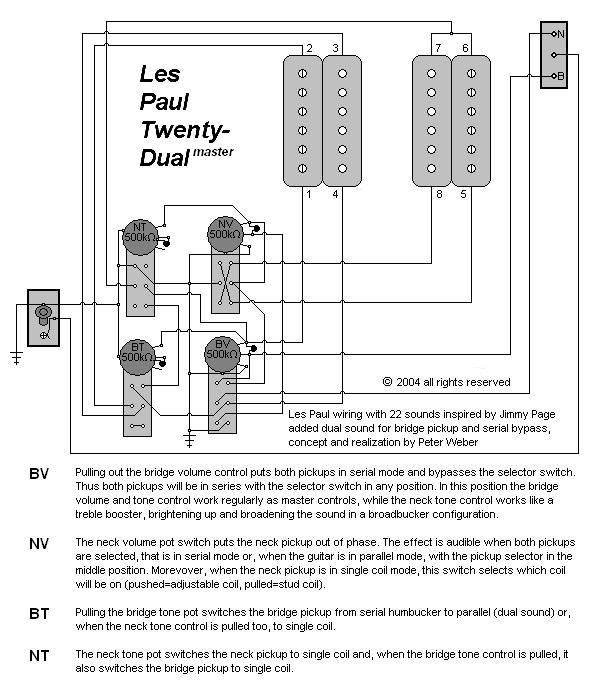 |
|
|
|
Post by borsanova on Jan 14, 2007 12:57:55 GMT -5
I've implemented my serial pickup selector bypass and everything works fine. It is a good improvement for switching flexibility, though the old configuration had some switching advantages too (especially when you sometimes find it hard to pull the bridge volume switch when going to solo). But for the rest the new design is better.
For a first evaluation I played Time Waits for No One starting with all single coil out of phase and then passing slowly to fatter sound until playing the second solo with all four coils in series. The passages were smooth and it is easy to get along with the push-pull switches. Just remember that pulling the bridge volume makes the sound thicker, while the other three will make it thinner.
|
|
|
|
Post by borsanova on Jan 21, 2007 7:58:01 GMT -5
As pointed out in the comments on my schematic, in series mode my guitar has different funtionality for the controls: the bridge controls work as master volume and tone, while the neck volume allows to dial in and out the amount of neck contribution and the neck tone allows to go for broadbucker sounds. Since those super distortion and broadbucker sounds will be used mostly when playing solo, I think that a master volume is indeed a very useful feature. However, JohnH has recently posted a JP-design with a different solution. In series mode his wiring preserves indeed the controls functionality of the parallel mode when both pickups are on, allowing to go for maximum flexibility in the mix, but without a master volume. Any guitar player who has ever laid his hands on a Les Paul knows this feature well and thus it may be an advantage, because you don't have to learn a new configuration. Soundwise this configuration has a little more flexibility, because it allows to dial out not only the neck, but also the bridge pickup. But since those super distortion sounds are already less brilliant, I don't think this adds too many useful choices to the available sound spectrum. Maybe it can become a bit more interesting with serial out-of-phase combos. In the end I guess it comes down to a question of players preferences. That's why I've been thinking about how to implement this feature in my Les Paul schematic and the solution is quite easy: simply cut the grounding connections of both bridge controls and connect them to the center lug of the series-switch. I don't think I'll build it, because I prefer the master volume, but I've adjusted my schematic and here it is (this preserves all other features of the "master" version, including the dual sound, but not the master volume in series mode): 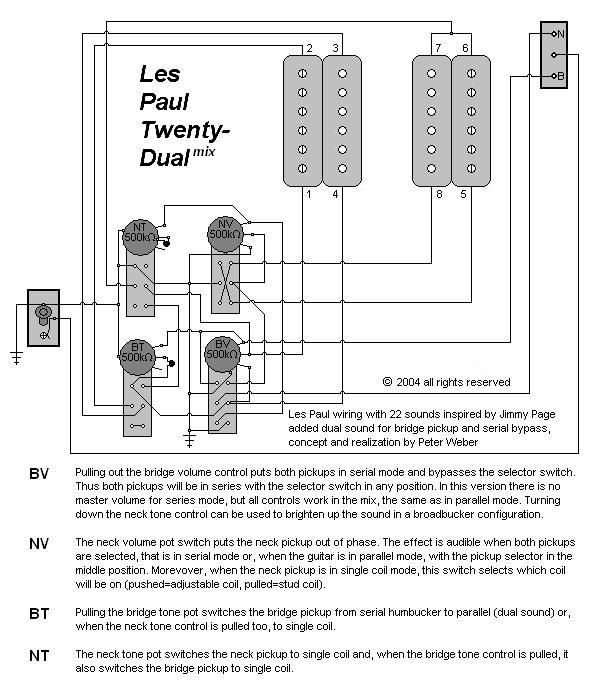 This is the version with the improvements suggested by JohnH (the former version above will be deleted soon): 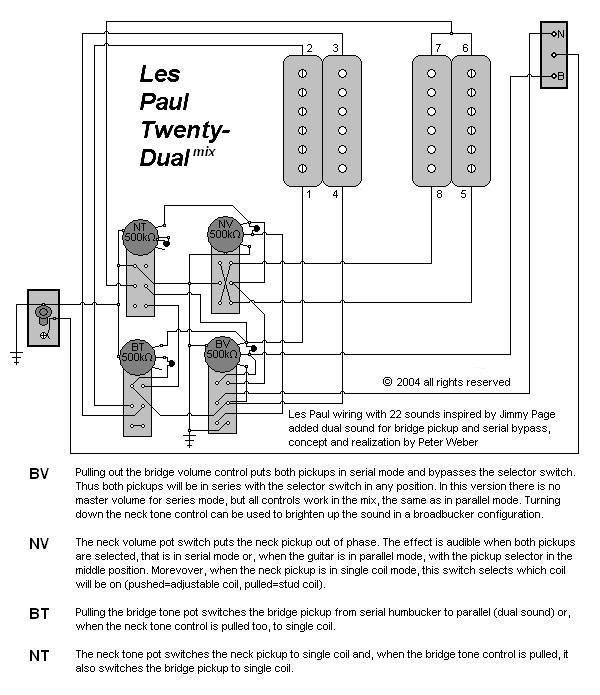 So now you got two versions of the Twenty-Dual: the Twenty-Dual mix and the Twenty-Dual master. Maybe you can let me know which one you prefer. How about a little poll? |
|
|
|
Post by JohnH on Jan 22, 2007 6:09:19 GMT -5
B
Your parallel/single switch is clever. I like how you can have that, and still get the combinations of single coil modes when you want them.
My main suggestions for improvement would be to put the tone controls on the pickup side of the volume control, where they can interact with the pups consitently at all volumes. Otherwise, as volumes are reduced, the impedance seen by the tone control rises greatly, and the tone control will cut much more deeply. For simlar reasons, I question the use of the reverse volume controls in series, where turning them down adds lot of resistance to the output impedance, resulting in the cable capacitance cutting more deeply into treble. I think ChrisK has a design where in series mode, the reverse volume controls become just a bypass to the pup, without the added resistance.
John
|
|
|
|
Post by borsanova on Jan 22, 2007 17:43:30 GMT -5
Your parallel/single switch is clever. I like how you can have that, and still get the combinations of single coil modes when you want them. I got it when studying the possibilities of reducing the number of three-coil combos which are never hum-cancelling. Now the only one remaining is the neck SC - bridge HB combination which is quite useful. My main suggestions for improvement would be to put the tone controls on the pickup side of the volume control, where they can interact with the pups consitently at all volumes. Otherwise, as volumes are reduced, the impedance seen by the tone control rises greatly, and the tone control will cut much more deeply. Do you mean I should connect the tone controls not to the one o'clock lug, but to the two o'clock lug (I call them one, two, three o'clock, though in my drawing they are actually at two, three and four o'clock)? I don't use those lower volumes too often, that's why I didn't care about that. But today I've checked it and I've noticed that especially in series mode with the master volume rolled back the master tone is a real sound killer. For simlar reasons, I question the use of the reverse volume controls in series, where turning them down adds lot of resistance to the output impedance, resulting in the cable capacitance cutting more deeply into treble. I think ChrisK has a design where in series mode, the reverse volume controls become just a bypass to the pup, without the added resistance. Today I was trying Mick Ronson's pickup selector trick at the end of John I'm Only Dancing and it was the first time I found it annoying that my Les Paul can't be shut down in the middle position. Since I'm planning to play that song with my band, I guess I'll have to fix that too (as well as the treble bleeds). So I'll have to invert the in and out connections on my volume controls. Well at least in this case the tone connections can remain where they are, right? I'll fix this in my schematics, too. But I can't do the same thing on my DeArmond T-400 design, because on that guitar the reverse current is needed to put the pickups in parallel out-of-phase. But the DeArmond has a master volume anyway, so this should be no problem. guitarnuts2.proboards45.com/index.cgi?board=schem&action=display&thread=1162666265 |
|
|
|
Post by UnklMickey on Jan 22, 2007 18:20:55 GMT -5
...So I'll have to invert the in and out connections on my volume controls. Well at least in this case the tone connections can remain where they are, right? ... yes. when you wire your volume controls "forward", if you don't move the connections for the tone controls, they will now be on the new input of the volume controls. i don't think of the tone controls as belonging on a certain lug of the volume controls. i prefer to think of them belonging on the "input" of the volume control, regardless of which direction the volumes are wired. cheers, unk |
|
albatross
Rookie Solder Flinger

Posts: 2 
Likes: 0
|
Post by albatross on Oct 15, 2008 10:02:47 GMT -5
Good afternoon everyone. I am attempting to do the Les Paul Twenty Dual Mix mod to my epiphone Les Paul Standard guitar with Dimarzio 4 conductor pickups. Mega Drive in the bridge and Super Distortion in the Neck. Could any of you be so kind as to provide me with color references of the pickups to the numbers in the picture of the pickups. Ie Bridge 1,2,3,4 relates to color1,color2,color3, color4, and Neck pickup 5,6,7,8...etc etc etc.. Any information would be appreciated. My guitar has been apart for 2 weeks trying to figure this out. Would like to get it back together to play some more....
Also, here's catch 22 added to the mix. I am a lefty, so I assume that the wiring is for righties and that the 2 outer connections to the pots would have to be reversed in this drawing, but leave the centers where they are....
Thank you all in advance for your help....
Regards....
|
|
|
|
Post by JohnH on Oct 15, 2008 15:01:58 GMT -5
This thread in our reference section has wiring colours: guitarnuts2.proboards45.com/index.cgi?board=reference&action=display&thread=3190For standard humbucker wiring, di Marzio's are wired: red to hot, green to ground and black and white together: So for Borsanovas version of the JP, I reckon 1, 5 = green 2, 6 = white 3, 7 = black 4, 8 = red Note there are different versions of JP wiring. Borsanovas has some good ideas though, but Im not sure if it has been tested and Borsanova has not been here for a while. His design adds the possiblity of parallel wiring of the bridge coils, which most do not have, and fixes a quirk or two with the control actions. If I ever build one, I'd do it a bit different though - see JHs JP in the schematics section. On the left right thing, unless you have left handed pots, (anti log instead of log), or linear pots, Id keep the conections to the pots as shown. A normal audio taper/log pot wired for anti-clockwise = increase in volume will be at almost max volume from 1 to 10. However, if you are not using standard audio pots, and want to have anticlockwise = increase, and have suitable knobs, then yes, you can swap the outer lug connections to each pot. I assume also you will arrange the controls per a lefty. John |
|
albatross
Rookie Solder Flinger

Posts: 2 
Likes: 0
|
Post by albatross on Oct 19, 2008 21:27:27 GMT -5
Thank you very much for the information. I finished wiring up my guitar tonight, and I love the modification. One more question I do have if anyone would be able to help me.... Does anyone have a listing of combinations that this setup (twenty-dual mix) has??? kind of like a lookup table showing what knob combinations get what coil configurations, and what the tone/volume knobs do in each combination?  Once again, thank you for your help..... Best Regards.... |
|
|
|
Post by borsanova on Sept 11, 2010 10:04:04 GMT -5
Sorry, I saw this request only today. Here is the lookup table for the Twenty Dual master or mix: Les Paul Twenty Dual (master/mix)
No. PU BV BT NV NT
01* R dn == == dn neck humbucker
02 R dn == dn up neck screw coil
03 R dn == up up neck slug coil
04* T dn dn == dn bridge humbucker
05* T dn up == dn bridge dual (parallel)
06 T dn up == up bridge screw coil
07* M dn dn dn dn bridge and neck humbuckers parallel
08* M dn up dn dn bridge dual and neck humbucker parallel
09 M dn dn dn up bridge humbucker and neck screw coil parallel
10* M dn up dn up bridge screw coil and neck screw coil parallel
11* M dn dn up dn bridge and neck humbuckers parallel out of phase
12* M dn up up dn bridge dual and neck humbucker parallel out of phase
13 M dn dn up up bridge humbucker and neck slug coil parallel out of phase
14* M dn up up up bridge screw coil and neck slug coil parallel out of phase
15* == up dn dn dn bridge and neck humbuckers in series
16* == up up dn dn bridge dual and neck humbucker in series
17 == up dn dn up bridge humbucker and neck screw coil in series
18* == up up dn up bridge screw coil and neck screw coil in series
19* == up dn up dn bridge and neck humbuckers in series out of phase
20* == up up up dn bridge dual and neck humbucker in series out of phase
21 == up dn up up bridge humbucker and neck slug coil in series out of phase
22* == up up up up bridge screw coil and neck slug coil in series out of phase
The combinations signed with * should be fully hum-cancelling. Moreover, by turning down the neck tone to zero, the combinations 15-18 can be turned to a broadbucker (TM) configuration with contemporarily more trebles and bass. The effect will be most evident with combination no. 16. |
|
|
|
Post by JohnH on Sept 11, 2010 17:48:28 GMT -5
bors - now you are back, I can ask a couple of questions about this:
In the last diagram posted above, when you pull BV to go into series mode, is it intended that the neck volume is active? - it seems the centre lug of the pot becomes disconnected in that case.
It looks like the tone pots are being viewed from the back, while the volume pots are viewed from the front - what do you think?
I will say, this mod was the first place where I saw how to use a dpdt to overide the main toggle in series mode - thanks for that, Ive used it ever since. And the extra ability to get bridge coils in parallel is also clever.
cheers
John
|
|
|
|
Post by borsanova on Sept 11, 2010 19:53:51 GMT -5
Hi John,
thanks for the questions.
to #1: I don't know if you refer to the master or the mix version. When the bridge volume switch is pulled on the master version, the bridge volume knob turns into a master volume. Thus the neck volume is not needed anymore. Therefore it is correct to disconnect it. But if I remember well, it still affects the sound somehow, maybe due to the treble bleed. I'll have to check this tomorrow.
The situation is different with the mix version where the neck volume is intended to continue working properly. If it were disconnected, that would be a bug. But it is still connected with the two outer lugs, though I don't know if this is enough to keep it working. Interesting question: since I only built the master version, at he moment I cannot tell you if there is actually an error in my schematic.
to #2: As I intended it, the whole schematic is having a front view on the guitar. So I copied what I found on my Epiphone. If I remember well, I flipped the volume pots' connections to the reverse wiring so they don't cancel each other with one of them at zero (later when I learned the machine gun effect I regretted a bit).
But I didn't change the lug connections on the tone pots. I admit that I'm always having some problem in understanding how potentiometer connections work and why some of them shut down the guitar and others not.
to #3:
I learned about the main toggle override on this board, but the dual bridge coils were my own idea and contribution to the further development of the Jimmy Page guitar.
|
|
|
|
Post by borsanova on Sept 12, 2010 13:20:38 GMT -5
Hi John,
I've been studying your new wiring schematic for the Twenty Dual mix and I must admit that there are a few points I don't get.
First, I think that there is a bug with the green wire on the 3-way-switch which shouldn't go to the middle lug of S2, but S1 instead.
Second, I don't understand how you rewired the right side of S1 and why you did it.
Third, I don't get which wires are grounded. For instance it seems in your diagram that the blue wire on S4 is always grounded. But this would be wrong in series mode. In my wiring schematic it is intended to be grounded only in parallel mode but in series mode it goes to the neck volume and pickup. Otherwise how could it be series mode?
Fourth, in my own schematic I am still in doubt over the functionality of the neck volume control, since you made me notice that its middle lug is disconnected. Let me know if you have some idea how to fix that. Or do you think it works anyway?
I controlled it on my master version and in series mode the neck volume pot affects the sound, but not like a volume control and it's most probably due to the bleed capacitor as I said.
|
|
|
|
Post by borsanova on Sept 12, 2010 13:23:20 GMT -5
Btw. maybe you should post your new schematic in this post to, so it would be easier to discuss.
|
|
|
|
Post by JohnH on Sept 12, 2010 15:54:41 GMT -5
OK, here is my version: 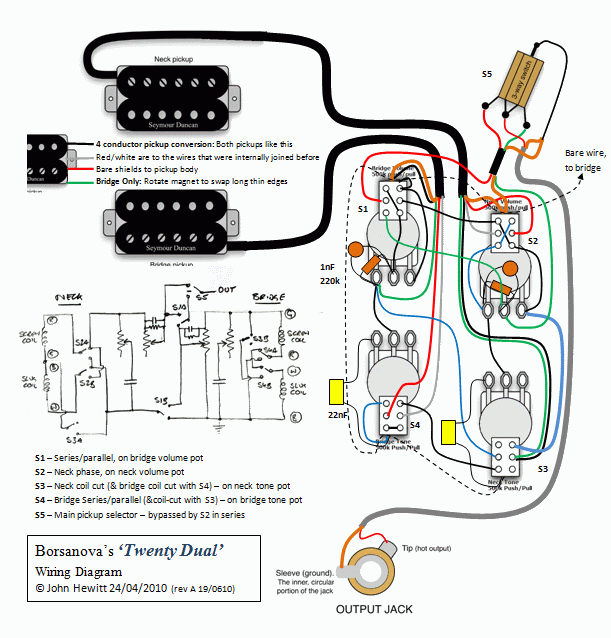 On your comments: the green wire from the 3-way toggle doesnt go to S2, but to the neck volume pot and also. via that to S1 My version is based on the schematic on my diagram, which I worked out based on previous designs, adapted to provide your functions. So it may well be a bit different to yours. The blue wire on S4 is always grounded, and its oK because I put the bridge pickup on the ground side when in series mode. Note that to get certain particular coisl active, but still optimise humcanecelling, the diagram is based on reversing one magnet and so moving coil colours appropriately. I did all the series/parallel switching after the volume pots, so they are always active - Ive got it that way on my own LP and it works well. My version got built twice, by 4real (who got it going in one hit), and raz59 (we got there in th end!), so we know it works. They seem to like your parallel bridge option very much. John |
|
|
|
Post by borsanova on Sept 12, 2010 17:44:07 GMT -5
Okay, I understand that this is even more different than I thought. I understand now that the green wire is the neck position and the red wire is the bridge (previously I thought the opposite since my schematic goes the other way). Now I have to see where it gets me. First I notice that you have a completely different way to override the 3-way-selector and I have to understand how you do it.
...
Yes, now it is clear and I've followed it through. First of all I learned that in your series mode you hook up first the neck pickup and then the bridge pickup. When I first came up with my broadbucker idea I thought that it would be impossible to achieve it that way. But then I learned that it was possible by hooking up the first pickup's capacitors like a bypass and two years ago I built it that way on my 345 copy which is working fine. Let me see where you hid that bypass ...
...
Oh yeah, there it is on S2: in series mode the volume capacitor (and resistor) is connected to the bridge pickup, thus bypassing the neck pickup. But the tone capacitor isn't. That's a minor downfall since it will work on both pickups instead of only one. Let's see if we can fix it.
...
Yes, we can! Instead of grounding it, the lower end of the tone capacitor on S3 should be connected to the upper right lug of the switch S3. Thus in series mode it will work as a bypass same as the volume cap.
I have to say that you did a great job on this wiring. You changed it completely round, but it seems you achieved the same goals and maybe even more, since I have that problem with the neck volume in series mode you made me notice. And at the moment I don't know how to fix it. I thought your wiring might give me some inspiration, but since it's so different I have to go on studying its secrets.
|
|
|
|
Post by borsanova on Sept 12, 2010 18:14:34 GMT -5
Well, I think I'm still a little confused since it's a long while that I didn't check such complicated wirings and sometimes it takes a while to remember all the secrets of my former inspiration. So here are a few precisations:
The capacitors on volume pots are always hooked up like a bypass, so it was stupid from me to look for that item. It was just the wrong place, since what I wrote applies to the tone control capacitor.
Thus I can say that on your wiring the neck tone control will not work independently and as a consequence broadbucker configuration will not work properly. That is, you can still use the bridge tone control to achieve the same electronic effect, but soundwise it's a stupid thing, since you muffle the treble pickup and leave the darker one unaffected and so, instead of broadening the sound, you will compress it.
With my little fix however you will be able to use the neck tone control for the same effect and this time your ears will be totally satisfied.
|
|
Raz59
Meter Reader 1st Class
  
Posts: 71
Likes: 1
|
Post by Raz59 on Sept 12, 2010 20:46:05 GMT -5
I'll chime in about the broadbucker mode in JohnH's drawing.
This is a very interesting setting. It is indeed the loudest setting when both humbuckers are on full. Weird things happen, though, and I don't know if they're intentional.
When I pull S1, I can still seemingly control how much signal each pickup is contributing to the mix with the volume and tone knobs. The toggleswitch seems to be bypassed seeing as flicking it up and down has no bad 'killswitching' effects or other weird stuff.
If, however, S1 and S2 are pulled (system series out-of-phase), if all the the knobs are on 10, the bridge tone knob gains a strange property and it doesn't cut the high frequencies normally.
It seems like the bridge's tone capacitor lost capacitance like from 22nF to 10nF and the resulting effect is more 'wah'-ish.
Borsa, what exactly did you intend to do? Bypass one pickup with a capacitor to mix in only the high frequencies of it?
I still don't quite get how JohnH managed to put the volume controls independent from each other in this design but that's my lack of experience talking. I can only make sense in the diagram, I think it's easy if you know how to properly read the supplied schematic.
|
|
|
|
Post by JohnH on Sept 12, 2010 21:51:03 GMT -5
As I,m sure bors will agree, series out of phase settings are very interesting, and sensitive to anything that changes the balance of harmonics between pickups. In these designs, that includes all four pots, and 'wah' effects are quite common with small knob changes. I've even heard sort of, 'auto-wah' effects, as the balance changes during decay, with no knob movements! My own current reference is this design - which has many of the same capabilities and principles as on this thread, but without the p/p pots: guitarnuts2.proboards.com/index.cgi?board=schem&action=display&thread=4571There are some sound samples there, and it would be interesting to hear if they sound anything like yours. John |
|
|
|
Post by borsanova on Sept 13, 2010 8:52:32 GMT -5
I'll chime in about the broadbucker mode in JohnH's drawing. This is a very interesting setting. It is indeed the loudest setting when both humbuckers are on full. Weird things happen, though, and I don't know if they're intentional. When I pull S1, I can still seemingly control how much signal each pickup is contributing to the mix with the volume and tone knobs. The toggleswitch seems to be bypassed seeing as flicking it up and down has no bad 'killswitching' effects or other weird stuff. If, however, S1 and S2 are pulled (system series out-of-phase), if all the the knobs are on 10, the bridge tone knob gains a strange property and it doesn't cut the high frequencies normally. It seems like the bridge's tone capacitor lost capacitance like from 22nF to 10nF and the resulting effect is more 'wah'-ish. Borsa, what exactly did you intend to do? Bypass one pickup with a capacitor to mix in only the high frequencies of it? I still don't quite get how JohnH managed to put the volume controls independent from each other in this design but that's my lack of experience talking. I can only make sense in the diagram, I think it's easy if you know how to properly read the supplied schematic. 1: As already pointed out, I wonder if there is a real broadbucker mode in John's drawing, at least without the mod I proposed. But then again it is easy to misinterpret maybe only one connection which changes all. 2: Full series is the loudest and fattest indeed. 3: The bypass on the 3-way-switch is also in the master version. But I still wonder if my mix design is good for individual volume controls. At least John's is. 4. I know what you're talking about. My master version does the same thing. It's a really cute wah sound and it's nice to add some special effect when ringing out a chord. Some results on my design go indeed far beyond what I've planned. In the first place I didn't even plan the broadbucker effect. I discovered it while playing around with my controls and only afterwards I came up with a rational explanation. As regards the wah effect, since John hooked up first the neck pickup, I thought you'd have it on the neck tone, but it seems you have it on the same as me. So what's happening here? I can make only a few suppositions. I agree with John that oop circuits create all kinds of interesting interaction between the two pickups. In some case they can even revert the current without switching, simply by manipulating the knobs. I don't know if that's what is happening here, but I used that trick on my DeArmond to achieve series, broadbucker and out-of-phase (three different sounds) with just one switch (view the respective thread). 5. Yes, that is exactly how broadbucker works. But you need to bypass the darker pickup at the neck to achieve a broadened sound. In this case you get the lower frequencies from both pickups, but the trebles only from the bridge. In the opposite case you get the trebles only from the neck, which doesn't make much sense. 6. I do, but I can't seem to translate it in my diagram. |
|
|
|
Post by JohnH on Sept 14, 2010 7:15:24 GMT -5
here'san updated diagram: 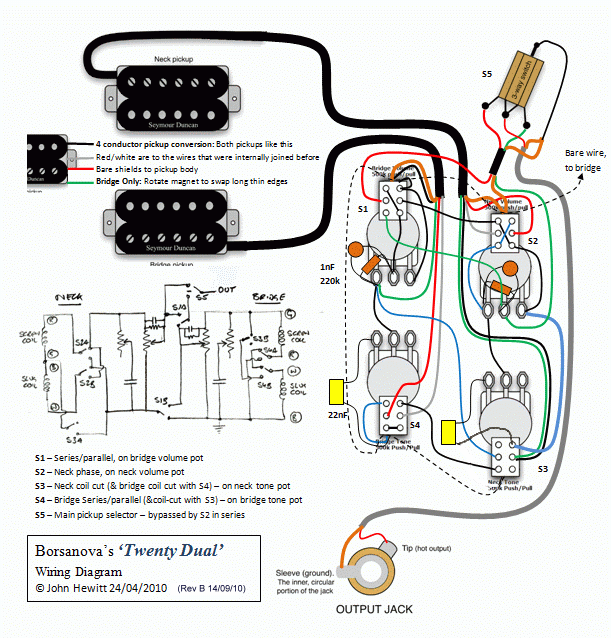 what do you think? All I changed was one wire on the neck tone cap. Do you see any other issues? John |
|
Raz59
Meter Reader 1st Class
  
Posts: 71
Likes: 1
|
Post by Raz59 on Sept 14, 2010 8:52:49 GMT -5
I don't know if discussion of the wiring is allowed in this section, please delete my posts if they are going against the rules.
Revision B puts quite a twist to the wiring. Before, the neck tone control would remain always a high-pass filter to ground.
Now...let's see, the other end of the capacitor is connected to NT's switche's lug. When S1 is pulled, the capacitor no longer sends high frequencies to ground; instead, they are sent straight to hot?
(I will change my guitar accordingly once I have new pickups instaled) What is to be expected in terms of sound? What is the difference between making the highs pass through the volume pot and just filtering them straight to the output?
|
|
|
|
Post by borsanova on Sept 14, 2010 15:15:24 GMT -5
They're not going to hot, but to the hot side of the bridge pickup and through that to ground. Since they didn't pick up any high frequencies from the neck pickup, the load is all hot to pick up what it can get from the bridge pickup.
|
|
|
|
Post by JohnH on Sept 14, 2010 15:46:18 GMT -5
At the weekend I could make a sound sample to show you the difference, I think of it like this: In series mode, for high frequencies, turning the neck tone to zero 'shorts out' the neck pickup, almost like bypassing it with a piece of wire. So there are almost no highs from the neck pup, but the highs from the bridge pup now have a direct route to hot, instead of having to fight past the neck pup, so they retain all their bridge character. Meanwhile for lows, the neck tone cap is not significant and you have both low-ends added together. I actually like this arrangement with both pickups, or maybe just the bridge, cut to a single coil. You get bridge-single-coil highs and full HB/series lows. There is one further effect that comes into play, a resonance betyween the neck pickup and the neck tone cap. On another thread, I modelled this in 5Spice:  THe model includes the inductance, capacitance and resistance of two vintage Hbs each reduced to a single coil, with the capacitor C7 representing the neck tone control fully turned down. On the right, are components modelling the guitar cord and amp. The graph shows the effect with various C7 tone cap values from 1nF up to 100nF. It assumes that each coil gets the same signal, so it does not know about position on the guitar. and this is the sort of frequency response that you get:  see the interesting dips! BTW Raz - if you are getting new pups do not start until we have discussed what wire goes where! Im sure you dont want another 8 pages of sorting it out. Well do some simple checks on the pups outside of the guitar. John |
|
|
|
Post by borsanova on Sept 14, 2010 16:25:02 GMT -5
I don't exactly understand why there is that huge bump around 1k, but it looks like representing quite well what I hear. The mids are somehow reduced, but without the result sounding twangy (on the contrary it takes out the twang if there was any). Moreover I confirm that it sounds even more interesting with a very trebly bridge pickup, that is, with a single coil or a dual humbucker.
|
|




